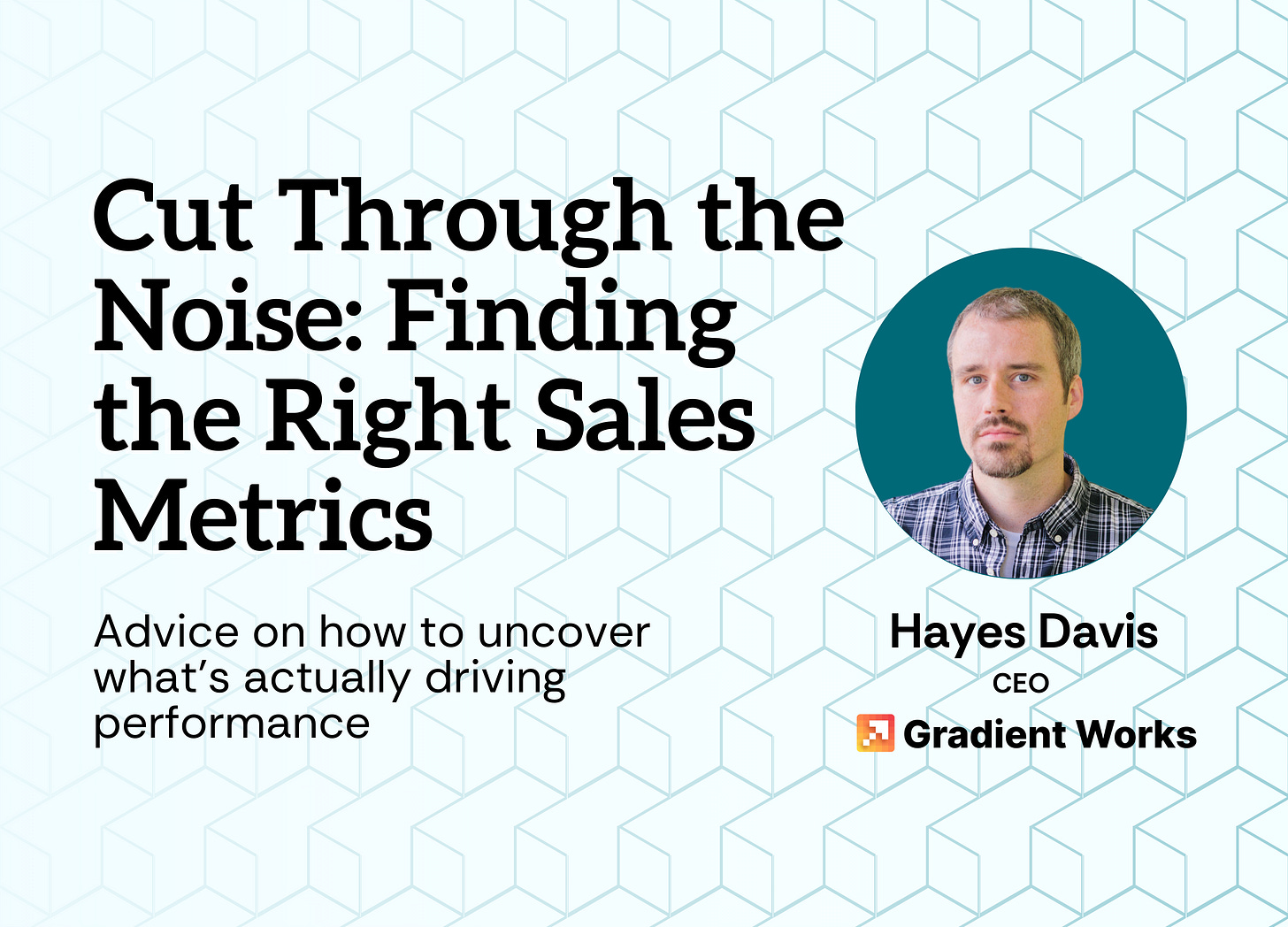Cut Through the Noise: Finding the Right Sales Metrics
Inherited a sales team? Advice on how to uncover what’s actually driving performance
DEAR STAGE 2: I just joined a new team and new company and inherited a team of 8 sellers. There is so much historical data to wade through and I’m trying to quickly figure out how to motivate this team to hit our 2025 goals. How do you identify the key data points that drive performance without getting lost in the data? ~OVERWHELMED BY DATA
DEAR OVERWHELMED BY DATA: Well folks, we have a guest post this week. When I read this question, I knew we had to get Hayes Davis involved. Hayes is the co-founder and CEO of Gradient Works, and RevOps guru. Read on to see how Hayes recommends breaking through the analysis paralysis that can come with joining a new company.
Trying to figure out where to focus can be daunting, especially if you look at it as one big, thorny problem. I recommend that you break the job down into steps:
Model the funnel (or bowtie)
Quantitative diagnosis
Qualitative diagnosis
Make a changes
Move with urgency—you’ve got a number to hit after all—but don’t skip steps.
Model the funnel
Start with high-level volume, conversion, and time metrics by working backward through the funnel (or the whole “bow tie” if you’re responsible for retention and expansion as well). If you’re not sure exactly what to measure, Winning By Design has a framework (see Chapter 5) that’s as good as any.
Resist the urge to diagnose and, whatever you do, don’t cherry-pick.
For example, if you’re looking at lead-to-opportunity conversion rates, resist the urge to immediately dive in if the rate is low and don’t listen (yet) to someone who says “oh we don’t count those leads for reason X”. This is one reason why you might be wary of existing historical conversion rate data. It often comes with baked-in assumptions that mask problems. Make sure you know precisely what’s being counted for volume metrics and what’s going into the numerator and denominator for conversion rate metrics. For time-based metrics (e.g. sales cycle), make sure you know when the clock starts (e.g, at opp creation? SQO? stage 4?). Generally speaking you should use this effort to get at your “raw” metrics before you start adjusting for anything else.
Chances are very good you won’t be able to get all the metrics you actually want here. Some things won’t be tracked at all, some things won’t have the right timestamps, etc. Don’t worry about it too much; this happens all the time. You can’t change the past, but you can impact the future. Work with your ops team to track these things going forward. The best time to solve this would have been a long time ago; the next best time is right now.
Quantitative Diagnosis
Once you’ve got your conversion rates, find your bottleneck. For example, if you have a 30% win rate but only convert 5% of leads to opportunities, increasing your win rate is unlikely to help. By the same token, increasing the volume of MQLs with more ads will just waste money.
Once you’ve found the bottleneck, now it’s time to dive deeper. This is when you should listen to how it’s been measured previously—just make sure to trust but verify. You should focus on trying to break down the metric into parts.
Let’s consider a very low outbound contribution to pipeline. There are two likely culprits here: the accounts are bad or something about the way reps work the accounts isn’t right. At this point, it would be helpful to try to break down the accounts according to your ICP or segments (if you have that defined) AND also look at performance by rep. You’re likely to find that some segments convert better or some reps convert better. Dig into those to see what the differences are.
In this particular case, consider two things:
Key diagnostic metrics like incubation period, opportunity creation rate and account coverage
Diagnostic Pyramid - Think of outbound as a set of layers, each building on the next: activities at the top, that’s made effective by messaging, which is made effective by persona/contact and—at the base—are the accounts you’re working. The top 3 layers (activity, messaging, contacts) are fairly easy to change but they’re heavily dependent on the bottom layer (accounts). Don’t just assume more activity will get you where you need to go.
Qualitative Diagnosis
Quantitative analysis will uncover likely issues but don’t start changing things just yet. Now is the time to really dig in on the qualitative side. Talk to your reps, talk to your colleagues on the leadership team and talk to your customers about why things have been done a certain way in the past. If you’re taking over a team of 8 reps, chances are good something hasn’t been going well. After all, most sales leaders are shown the door within two years. But don’t let that make you assume your predecessor was an idiot. Assume positive intent all around and try to make sure you understand why a competent person would have made certain choices.
Ask lots of questions about deals and listen to call recordings. Make your own judgments (that’s why you’re here!) but also keep an open mind.
Make Some Change
Once you’ve done all of the above, then you’re ready to start making changes. Chances are good you’ll need to make quite a few changes but recognize that forcing through 20 changes at once is likely to result in nothing changing. Focus on 2-3 things that will have the most impact on your bottleneck and reinforce the hell out of them. Once those are in place, move on to the next bottleneck and do it all over again.
A huge thank you to Hayes Davis, Co-Founder & CEO of Gradient Works, for contributing to this week’s Dear Stage 2. Until next week!



